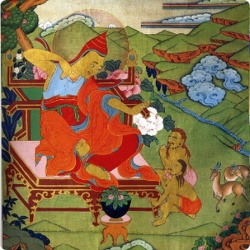Dharmakirti
Dharmakīrti (ca. 7th century), was an Indian scholar and one of the Buddhist founders of Indian philosophical logic. He was one of the primary theorists of Buddhist atomism, according to which the only items considered to exist are momentary states of consciousness.
History
Born around the turn of the 7th century, Dharmakirti was a South Indian Brahmin and became a teacher at the famed Nalanda University, as well as a poet. He built on and reinterpreted the work of Dignaga, the pioneer of Buddhist Logic, and was very influential among Brahman logicians as well as Buddhists. His theories became normative in Tibet and are studied to this day as a part of the basic monastic curriculum.
Collins colourfully contextualized Dharmakirti and his experience of disaffection and collegiate misunderstanding at Nalanda:-
Dharmakirti's synthesis is the apex of Buddhist philosophy, at the moment when it was institutionally fading. Nalanda was still bustling, buoyed by cosmopolitan incursions of Brahmans and lay students, but the weeds were growing around the deserted stupas not just in the south but in northern India as well. Dharmakirti is the last flaming of the torch before it blows out, the owl of Minerva taking wing at dusk: the creativity of synthesis as a fading institutional base goes on the defensive. Dharmakirti himself was a lay Buddhist, not a devout monk, and his personal tone sounds like secular ambition rather than a quest for salvation. The closing stanza of his great work laments the dearth of capable intellectuals to follow his philosophy: "My work will find no one in this world who would easily grasp its deep sayings. It will be absorbed and perish in my own person, just as a river in the ocean." A Tibetan historian says that when he finished the work, his pupils showed no appreciation, and his enemies "tied up the leaves [of the palm-leaf manuscript] to the tail of a dog and let him run through the streets where the leaves became scattered" (Stcherbatsky, 1962: 1:35-36). In fact, Dharmakirti did end up dominating the leading philosophers of the last generations of Indian Buddhism. But his pessimism was prescient. Leaving Nalanda, he retired to his home in the south, where he founded a monastery. The next successful Brahman student from the south was to be Shankara, and when he came north, it would be to plunder the carcass of a dying [Indian] Buddhism.
Writings
The Seven Treatises on Valid Cognition:
Saṃbandhaparikṣhāvrtti (Analysis of Relations)
Pramāṇaviniścaya (Ascertainment of Valid Cognition)
Pramāṇavārttikakārika (Commentary on Dignaga's 'Compendium of Valid Cognition')
Nyāyabinduprakaraṇa (Drop of Reasoning)
Hetubindunāmaprakaraṇa (Drop of Reasons)
Saṃtānāntarasiddhināmaprakaraṇa (Proof of Others' Continuums)
Vādanyāyanāmaprakaraṇa (Reasoning for Debate)
Philosophy
Dharmakirti presents most of his ideas in the guise of commentary on Dignaga's works, even if his theories go beyond what was presented by his predecessor. Some of his ideas, like his proof for the authority of the Buddha's words, are innovations, for Dignaga considered language just as fallible as inference.
There has long been disagreement among Indian and Tibetan doxographers as to how to categorize Dharmakirti's thought. The Gelug school asserts that he expressed Yogachara views, most non-Gelug Tibetan commentators assert that he expressed Sautrantika views and, according to one Tibetan source, a number of renowned later Indian Madhyamikas asserted that he expressed Madhyamaka views.
Stcherbatsky relates Dharmakirti to his own understanding of Kant. He compares Dharmakirti’s ‘point-instant’ to Kant’s thing in itself.
“ The fundamental difference between the Kantian Thing-in-Itself and Dharmakirti’s ‘Own essence’ consists in the clear identification of the latter with a single point instant of reality which corresponds to a moment of sensation”. ”
Mindstream: the play of beginninglessness and temporality, a continuum
Dharmakīrti (fl. 7th century) wrote a treatise on the nature of the mindstream in his Substantiation of Other Mindstreams (Saṃtãnãntarasiddhi). Ratnakīrti (fl. c7-8th century), a disciple of Dharmakīrti, wrote a work that further developed and refined the themes therein, entitled: 'Refutation of Other mindstreams' (Saṃtãnãntaradusana). He did not refute the tenets of the Saṃtãnãntarasiddhi but further developed the topic from an empirical one, that is, where there are manifold minds cognized by one's experience of others' mental processes attributed through the perceived actions of other sentient beings to an absolutist view, where there is only "one mindstream" (ekacitta). Ratnakīrti's argument is that the valid cognition (pramāna) of another's mindstream is an inference (anumāna), not a direct perception (pratyakṣa). Moreover, Ratnakīrti introduced the two truths doctrine as key to the nature of the discussion as inference is trafficking with illusiory universals (samanya), the proof of the mindstreams of others, whilst empirically valid in relative truth (saṃvṛtisatya), does not hold ultimate metaphysical certainty in absolute truth (paramārthasatya).
Dharmakirti held the mindstream to be beginningless yet also described the mindstream as a temporal sequence, and that as there are no true beginnings, there are no true endings, hence, the "beginningless time" motif that is frequently used to describe the concept of mindstream, as Dunne relates:
Buddhist philosophers often speak of beginninglessness. It is claimed that the minds of living beings, for example, have no beginning, and that our current Universe is only one in a beginningless cycle of expansion and decay. Some Buddhist thinkers would claim that even the most mundane task can have no true beginning. That is, if a beginning occurs, there must be some moment, some "now", in which it occurs. For the present to exist, however, there must be a past and a future, for what would "now" mean if there were no time other than now? And of course, if there is a past, then how could now be a beginning? Now should instead be the end of the past. Each beginning in short, must itself have a beginning.

